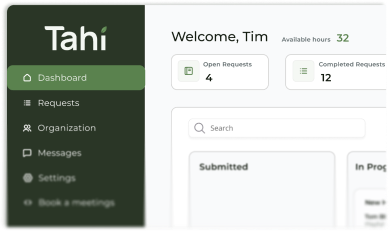Strategy
How to Write a Brief Agencies Actually Love
Tired of projects going off the rails? Your project brief might be the culprit. Learn how to write a brief that great agencies love and get better results.

The Mindset Shift: From To-Do List to Strategic Blueprint
Let's be honest. When a web project goes sideways, the agency often gets the blame. But having been on the receiving end of briefs for years, I can tell you that the success or failure of a project is often sealed long before we get involved. It happens the moment you start writing the project brief.
Many businesses see the brief as a glorified to-do list. “We need a five-page website with a blog and a contact form.” While that information is necessary, it’s the least important part. The briefs that make our team genuinely excited, the ones that lead to groundbreaking work, are those that focus on strategy over tactics. They tell us *why* we’re building something, not just *what* we’re building.
I remember a turning point with one client. Their initial brief was standard fare, focused on lead generation and conversion rates. But in our kickoff call, we dug deeper. It turned out their primary goal wasn't immediate sales. They told us they cared more about establishing brand presence and trust. This single insight was a game-changer. It transformed the entire website strategy from a direct marketing tool into a powerful digital billboard, designed to showcase who they were in the best possible way. That’s the strategic clarity a great brief provides.
The Anatomy of a Powerful Project Brief
A brilliant brief is your project's single source of truth. It’s the document that aligns everyone, from your internal stakeholders to your agency partner. It ensures that the work isn't just creative, but effective. Here are the core components we look for.
1. Project Background and Business Context
Before an agency can solve your problem, they need to understand it. Your project doesn't exist in a vacuum. Provide the context that led to this moment.
- Why this project? What's the core business problem you're trying to solve? Are you losing market share to a competitor? Is your current site failing to represent your brand's quality?
- Why now? What's the urgency? Is there a new product launch on the horizon, or a key sales period you need to prepare for?
- What’s the history? Have you tried to solve this before? What worked and what didn't? Sharing past results, good or bad, is incredibly valuable.
Thinking through these questions is a crucial first step. If you're struggling to define the problem, it might be worth asking some foundational questions first, like the ones in our guide, Is Your Website Truly Working?.
2. Crystal Clear Objectives and Success Metrics
“A new website” is not an objective; it’s a deliverable. An objective is a measurable business outcome. The best briefs clearly define what success looks like, so everyone is aiming for the same target. Vague goals lead to vague results.
Instead of saying:
- “We want to improve our online presence.”
Try being specific:
- “We aim to increase organic traffic by 20% within six months of launch.”
- “We want to decrease our bounce rate on key landing pages by 15% in Q3.”
- “Our goal is to generate 50 qualified sales leads per month through the new contact form.”
Defining these metrics upfront ensures the agency's work is tied directly to your business goals. It's the difference between getting a pretty website and getting a website that performs. This focus on tangible outcomes is central to what we consider quality Webflow development.
3. Deep Audience Intelligence
Who are we building this for? “Everyone” is not an answer. A detailed picture of your target audience is crucial for effective design, copy, and user experience. Go beyond basic demographics.
A great audience profile includes:
- Demographics: Age, location, job title. (The basics)
- Psychographics: What are their values, goals, and motivations? What keeps them up at night?
- Pain Points: What specific problems do they face that your product or service solves?
- Watering Holes: Where do they hang out online? What blogs do they read? What social media platforms do they use?
The more detailed you can be, the better. Providing a clear Ideal Client Profile (ICP) gives the creative team the fuel they need to build something that truly resonates.
4. Budget Transparency (The Awkward Bit)
Let's talk about the uncomfortable part: money. Many clients treat their budget like a state secret in a high-stakes poker game, worried that if they reveal their hand, the agency will simply charge that amount.
Here's a blunt truth from the other side of the table. We're not trying to squeeze every last dollar out of you. We're trying to give you the maximum possible value for what you can realistically invest. An honest budget allows us to do that.
Being upfront about your budget helps an agency to:
- Scope Realistically: We can propose a solution that fits your budget, rather than pitching an all-singing, all-dancing website that costs $100,000 when you only have $30,000.
- Maximise Value: Knowing the budget allows us to recommend where to focus the investment for the biggest impact. Maybe that complex animation isn't as important as a robust CMS setup.
- Build Trust: Transparency builds trust from day one. It shows you're serious and ready for a partnership.
For more on this, we've written about smart Webflow budgeting. It’s about investing strategically. Our own pricing is public because we believe in this transparency.
5. The Messaging Framework and Deliverables
With the strategic foundation laid, you can now get into the specifics of the 'what'. This section should be detailed to avoid ambiguity and prevent painful scope creep later on.
- Key Messages & Tone of Voice: How do you want to sound? Are you professional and authoritative, or fun and quirky? What are the top three things you want your audience to take away? If you have a Brand Bible or Style Guide, include it.
- Specific Deliverables: List everything you expect to receive. Be precise. Instead of “website design,” specify “High-fidelity designs for 5 unique page templates in Figma” or “A fully developed 10-page Webflow site with a dynamic blog.”
- Technical Specifications: If you have specific technical needs, list them. This includes required integrations, file formats, or accessibility standards. Clarity here helps avoid long-term technical debt.
Setting the Project Up for a Smooth Process
A great brief doesn't just outline the work; it outlines how the work will get done. Including details about process and collaboration shows an agency you’re thinking like a partner, not just a client.
Key Stakeholders and Decision-Makers
Nothing slows a project down like design by committee. Your brief should identify the key stakeholders involved and, most importantly, designate a single point of contact who has the authority to make final decisions. This streamlines communication and keeps the project moving forward.
The Power of Collaboration
The best client-agency relationships are partnerships. As an agency, we don't want a brief handed to us like a stone tablet. We want it to be the start of a conversation. Indicate that you're open to feedback and collaboration. An agency's experience can help refine your ideas and often leads to a better outcome. An effective agency partnership is built on this kind of mutual respect and dialogue.
Inspiration and References
Including examples of websites, designs, or features you like is incredibly helpful. But don't just drop links. Explain *why* you like them. Is it the clean layout? The clever copywriting? The smooth user experience? This context helps the agency understand your taste and strategic thinking, rather than just copying a competitor.
Your Brief is an Investment in Success
Writing a comprehensive project brief takes time. It requires you to think deeply about your business, your goals, and your audience. But it’s one of the highest-leverage activities you can undertake.
A great brief saves time, reduces friction, and aligns everyone around a shared vision of success. It's the difference between a project that feels like a struggle and one that feels like an energising collaboration. It’s the first and most critical step in building a digital presence you can be proud of.
Ready to build a solid foundation for your next project? A great place to start is understanding where your current site stands. Get a free, no-obligation site audit from our team, or take a look at our subscription plans to see how we build partnerships from day one.








